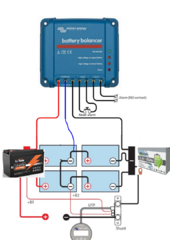MaikaiLife
Solar Enthusiast
If I have 3x 12v batteries connected in the following configuration.
1: 100 amp
2: 100 amp
3: 70 amp
So, if batteries 2 & 3 (Group A) are put in parallel, it's 12v at 170 amps.
If I put battery group (A) in a series with the 1st battery, I have 24v now. So my math memory recalls that you divide the number by 2 since the voltage is doubled.
270 amp / 2 = 135 amps at 24v.... Am I missing anything?
1: 100 amp
2: 100 amp
3: 70 amp
So, if batteries 2 & 3 (Group A) are put in parallel, it's 12v at 170 amps.
If I put battery group (A) in a series with the 1st battery, I have 24v now. So my math memory recalls that you divide the number by 2 since the voltage is doubled.
270 amp / 2 = 135 amps at 24v.... Am I missing anything?





